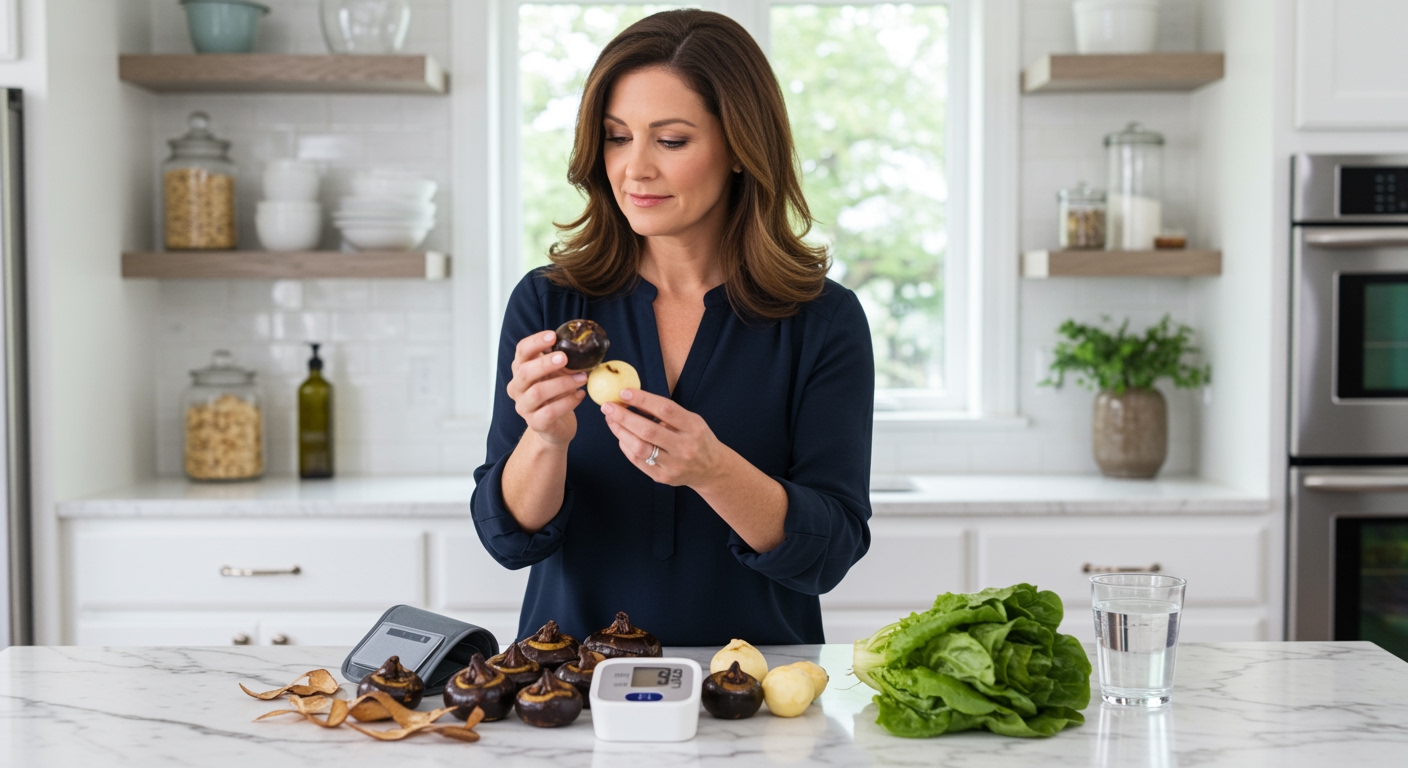✪ Key Takeaway: Water chestnuts may help lower blood pressure through potassium content and antioxidants, but evidence remains limited.
Introduction
Your doctor just told you that your blood pressure is creeping up again.
You might be wondering if there are natural foods that could help bring those numbers down without relying solely on medication.
Hi, I’m Abdur, your nutrition coach and today I’m going to explain whether water chestnuts can actually help lower your blood pressure and what the science really says about this crunchy vegetable.
What Makes Water Chestnuts Special for Blood Pressure?
Water chestnuts contain several compounds that researchers believe might influence blood pressure regulation.
The most important component is potassium, which plays a crucial role in balancing sodium levels in your body.
When you consume adequate potassium, your kidneys can better eliminate excess sodium through urine.
This process helps relax blood vessel walls and reduces the pressure your heart needs to pump blood throughout your body.
Water chestnuts also contain antioxidants like phenolic compounds that may protect your blood vessels from damage caused by free radicals.
These antioxidants help maintain the flexibility of your arterial walls, which is essential for healthy blood pressure levels.
✪ Fact: One cup of water chestnuts provides about 362 milligrams of potassium, roughly 8% of your daily needs.
How Much Potassium Do Water Chestnuts Actually Provide?
The potassium content in water chestnuts is moderate compared to other vegetables known for blood pressure benefits.
A single cup of sliced water chestnuts contains approximately 362 milligrams of potassium.
To put this in perspective, the same amount of spinach provides about 840 milligrams, while a medium banana offers around 422 milligrams.
The American Heart Association recommends adults consume about 4,700 milligrams of potassium daily for optimal blood pressure control.
This means you would need to eat about 13 cups of water chestnuts to meet your daily potassium requirements from this source alone.
However, water chestnuts can still contribute meaningfully to your overall potassium intake when combined with other potassium-rich foods throughout the day.
✪ Pro Tip: Combine water chestnuts with leafy greens and avocados to maximize your potassium intake naturally.
What Does Research Say About Water Chestnuts and Blood Pressure?
Direct research on water chestnuts and blood pressure is surprisingly limited in the scientific literature.
Most studies focus on the broader category of potassium-rich vegetables rather than water chestnuts specifically.
However, extensive research shows that increasing dietary potassium intake can lead to modest reductions in both systolic and diastolic blood pressure.
A comprehensive review of multiple studies found that potassium supplementation reduced systolic blood pressure by an average of 3.5 mmHg and diastolic pressure by 2.0 mmHg.
The antioxidant compounds in water chestnuts have been studied for their potential cardiovascular benefits, but most research remains in preliminary stages.
Some laboratory studies suggest these compounds may help improve endothelial function, which refers to how well your blood vessels can dilate and contract.
✪ Note: Most blood pressure research focuses on overall dietary patterns rather than individual foods like water chestnuts.
Are There Any Risks or Considerations?
Water chestnuts are generally safe for most people when consumed as part of a balanced diet.
However, there are several important considerations to keep in mind if you have high blood pressure.
If you take blood pressure medications, particularly ACE inhibitors or potassium-sparing diuretics, adding large amounts of potassium-rich foods might cause your potassium levels to become too high.
This condition, called hyperkalemia, can be dangerous and affect your heart rhythm.
People with kidney disease should be especially cautious about increasing potassium intake, as damaged kidneys cannot effectively remove excess potassium from the blood.
Water chestnuts are also relatively high in carbohydrates, containing about 15 grams per cup, which diabetics should factor into their meal planning.
✪ Pro Tip: Always consult your doctor before making significant dietary changes if you take blood pressure medications.
How Should You Include Water Chestnuts in Your Diet?
The best approach is to incorporate water chestnuts as part of an overall heart-healthy eating pattern rather than relying on them as a magic bullet.
Fresh water chestnuts provide the most nutritional benefits, though canned varieties can be convenient alternatives.
When buying canned water chestnuts, choose varieties packed in water rather than syrup to avoid added sugars.
You can add sliced water chestnuts to stir-fries, salads, soups, or eat them raw as a crunchy snack.
Their mild flavor and satisfying texture make them versatile ingredients that pair well with many dishes.
Remember that sustainable blood pressure management requires a comprehensive approach including regular exercise, stress management, adequate sleep, and limiting sodium intake.
✪ Fact: The DASH diet, proven to lower blood pressure, emphasizes vegetables like water chestnuts alongside fruits and whole grains.
The Bottom Line
Water chestnuts can be a helpful addition to a blood pressure-friendly diet, but they are not a standalone solution for hypertension.
Real health improvements come from consistent daily choices, not from searching for miracle foods.
I would love to hear about your experiences with incorporating water chestnuts or other vegetables into your diet for blood pressure management, so please share your thoughts and questions in the comments below.
References
At NutritionCrown, we use quality and credible sources to ensure our content is accurate and trustworthy. Below are the sources referenced in creating this article:
- WebMD: Health Benefits of Water Chestnuts
- RupaHealth: Amazing Facts About Water Chestnuts Health Recipes and More
- MedicineNet: What Exactly Are Water Chestnuts





